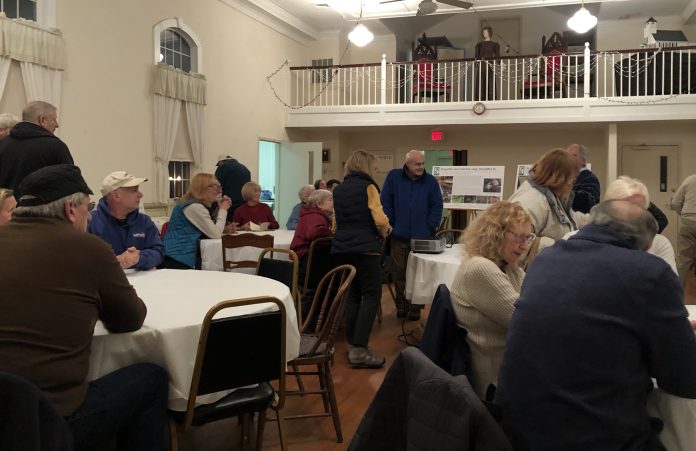NORTH SMITHFIELD – More than 60 percent of Rhode Island’s forests are privately owned, and conservationists know that taxes on large plots can be steep, while the economic incentives to develop them are hard to ignore.
But there are alternatives for landowners who hope to preserve their properties, and on Thursday, Feb. 13, locals got a free education on how to qualify for a state tax incentive program that can help.
The meeting, sponsored by the Burrillville Land Trust along with Engage North Smithfield, North Smithfield Heritage Association, Rhode Island Association of Conservation Commissions and the Rhode Island Forest Conservators Organization, brought dozens of guests to North Smithfield’s Heritage Hall. Certified forester Marc Tremblay gave a presentation on the program, aimed at protecting land across Rhode Island from further development.
Land Trust President Paul Roselli provided an introduction, explaining how he, personally, became involved in conservation. Roselli grew up in Providence, and noted that his house was once surrounded by small-scale farms, but things had changed by the time he left for college.
“The rural character of that land had changed drastically,” said Roselli. “I wanted that sense of place again. I wanted that rural character. Not just with the people, but with the land.”
“Somehow we’ve disconnected from the land that we love,” Roselli said. “When you walk around these woods you see extraordinary things. As you walk in the woods, you catch glimpses of what things used to be.”
“In these woods in the north west corner of Rhode Island, life flourishes.”
Tremblay, also a Burrillville resident, discussed Rhode Island’s Farm Forest and Open Space Act.
Established in 1980, the act provides three categories of land that qualify for reduced taxes: farmland, forestland and open space. The law allows property enrolled the program to be assessed at its current use, not its value for development.
Before the law was established, Tremblay noted, “Farmers were forced to sell ten acres a year just to pay their tax bill.”
Tremblay pointed to benefits of enrollment including water quality protection, improved forest health, protecting wildlife habitats, and improved access for recreation.
“It’s not just to save on your tax bill, although that is a big benefit,” he said. “It’s also to make your land more productive, because you’re going to get help.”
The Farmland classification, Tremblay noted, is for landowners with at least five acres that are actively devoted agricultural and horticultural use, and subsistence farmers. Participants must fill out a Farmland Classification application with a map of the property, and a written USDA Farm Conservation Plan approved by USDA Natural Resources Conservation Service.
“It’s based on the productivity of the land,” Tremblay explained.
Land that qualifies for the Forestland classification, meanwhile, must be ten acres or more, excluding either a house lot or one acre. The forest must be actively managed in accordance with the provisions of a written forest stewardship plan.
A member of RI Forest Conservator’s Organization, Tremblay noted that consulting on forest management is his area of expertise.
“Most of it is owned by folks just like yourselves,” he said. “There’s plenty of room for more conservation.”
Tremblay noted that the Open Space classification is the easiest of the three to obtain. Property owners with 10 acres or more must file an application with a soil map, which can be obtain from local Conservation Districts.
Values of the three classifications are updated periodically, and certificates must be submitted annually to municipal tax assessors.
There are penalties, however, if land that classifies for the tax incentive is developed within 15 years. If land is sold, the new owner is notified that the property is enrolled in the program and given the option to continue the classification or withdraw.
A brief question and answer session followed the presentation, and Tremblay noted that for those with very large plots, the savings can add up.
Still, he said, “It is not going to compete with someone who is waving a million dollars in your face.”
More information, and an applications to qualify for the incentives can be found here.







